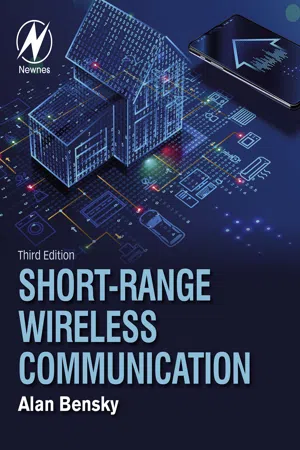
- 462 pages
- English
- ePUB (mobile friendly)
- Available on iOS & Android
Short-range Wireless Communication
About this book
Short-range Wireless Communication, Third Edition, describes radio theory and applications for wireless communication with ranges of centimeters to hundreds of meters. Topics covered include radio wave propagation, the theory of antennas and transmission lines, architectures of transmitters, and radio system design guidelines as a function of basic communication parameters, such as sensitivity, noise and bandwidth. Topics new to this edition include MIMO, metamaterials, inductance coupling for loop antennas, very high throughput Wi-Fi specifications, Bluetooth Low Energy, expanded coverage of RFID, wireless security, location awareness, wireless sensor networks, Internet of Things, millimeter wave and optical short-range communications, body area networks, energy harvesting, and more.Engineers, programmers, technicians and sales management personnel who support short-range wireless products will find the book a comprehensive and highly readable source to boost on-the-job performance and satisfaction.- Presents comprehensive, up-to-date coverage of short-range wireless technologies- Provides an in-depth explanation of wave propagation and antennas- Describes communication system components and specifications, including transmitters, receivers, frequency synthesizers, sensitivity, noise, distortion, and more- Includes an introduction to error detection and correction
Frequently asked questions
- Essential is ideal for learners and professionals who enjoy exploring a wide range of subjects. Access the Essential Library with 800,000+ trusted titles and best-sellers across business, personal growth, and the humanities. Includes unlimited reading time and Standard Read Aloud voice.
- Complete: Perfect for advanced learners and researchers needing full, unrestricted access. Unlock 1.4M+ books across hundreds of subjects, including academic and specialized titles. The Complete Plan also includes advanced features like Premium Read Aloud and Research Assistant.
Please note we cannot support devices running on iOS 13 and Android 7 or earlier. Learn more about using the app.
Information
Introduction
Abstract
Keywords
1.1 Historical perspective
1.2 Reasons for the spread of wireless applications
- • We now can employ higher and higher frequencies in the spectrum whose use was previously impossible or very expensive. In particular, solid-state devices have been developed to amplify at millimeter wavelengths, or tens of gigahertz. Efficient, compact antennas are also available, such as planar antennas, which are often used in short-range devices. The development of surface acoustic wave (SAW) frequency-determining components allow generation of UHF frequencies with very simple circuits.
- • Digital modulation techniques have largely replaced the analog methods of previous years, permitting a multiplication of the number of communication channels that can occupy a given bandwidth.
- • We have seen much progress in circuit miniaturization. Hybrid integrated circuits, combining analog and digital functions on one chip, and radio-frequency integrated circuits are to a large part responsible for the amazingly compact size of cellular telephone handsets. This miniaturization is not only a question of convenience, but also a necessity for efficient design of very short-wavelength circuits.
1.3 Characteristics of short-range radio
- • RF power output of several microwatts up to 100 milliwatts
- • Communication range of centimeters up to several hundred meters
- • Principally indoor operation
- • Omnidirectional, built-in antennas
- • Handheld, mobile terminals
- • Simple construction and relatively low price in the range of consumer appliances
- • Unlicensed operation
- • Noncritical bandwidth specifications
- • UHF operation
- • Battery-operated transmitter or receiver
1.4 Short-range radio applications
| Application | Frequencies (MHz) | Characteristics |
|---|---|---|
| Security Systems | 300-500, 800, 900 | Simplicity, easy installation |
| Emergency Medical Alarms | 300-500, 800 | Convenient carrying, long battery life, reliable |
| Computer Accessories—mouse, keyboard | UHF | High data rates, very short range, low cost |
| RFID | 100 kHz—2.4 GHz | Very short range, active or passive transponder |
| WLAN | 2.4, 5-6 GHz | High continuous data rates, spread spectrum and OFDM modulation |
| WPAN | 2.4 GHz | Medium data rates, low cost |
| Wireless Microphones; Wireless Headphones | VHF, UHF | Analog high fidelity voice modulation, moderate price |
| Keyless Entry—Gate, car door openers | UHF | Miniature transmitter, special coding to prevent duplication |
| Wireless bar code readers | 900 MHz, 2.4 GHz | Industrial use, spread spectrum, expensive |
| Wireless power meters | 2.4 GHz | Realtime measurement of electricity consumption and instantaneous demand |
| Internet of Things (IOT) | UHF, 2.4 GHz | Wireless monitoring and control of appliances and industrial apparatus with minimum human intervention |
Table of contents
- Cover image
- Title page
- Table of Contents
- Copyright
- Dedication
- Preface
- Engineering Worksheets
- Abbreviations
- Chapter 1: Introduction
- Chapter 2: Radio propagation
- Chapter 3: Antennas and transmission lines
- Chapter 4: Communication protocols and modulation
- Chapter 5: Signal generation and transmitters
- Chapter 6: Receiver and digital radio architectures
- Chapter 7: Radio system design
- Chapter 8: System implementation
- Chapter 9: Introduction to information theory and coding
- Chapter 10: Regulations and standards
- Chapter 11: Wireless local area networks
- Chapter 12: Wireless personal area networks
- Chapter 13: Radio frequency identification (RFID)
- Chapter 14: Technologies and applications
- Index